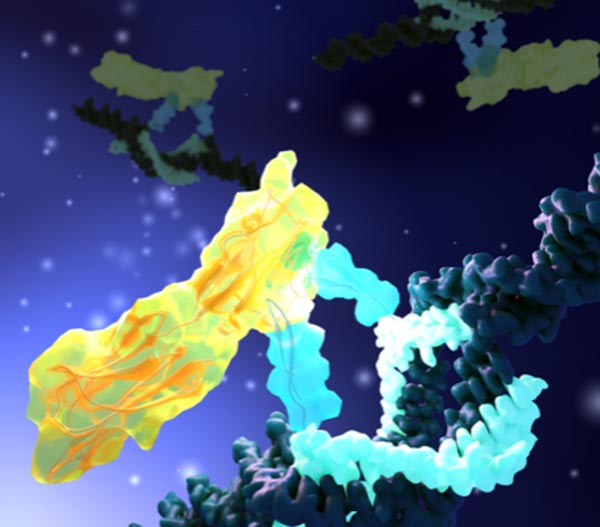Discovering new drugs with Darwin

Representation of assembly (light blue) that recognize and binds PD-L1 (yellow).
Credit: UNIGE
Chemists at the UNIGE have developed a new technique for selecting assemblies of molecules, making it possible to find the best combinations for each protein to be combated quickly and cheaply.
Our body must constantly defend itself against bacteria and viruses. It generates millions of different antibodies, which are selected to recognise the enemy and trigger the best possible immune response. Scientists use these antibodies to for therapeutic purposes to target proteins and disrupt their harmful. However, identifying the small molecules that will form the basis of the drug is a long and tedious process.
Chemists at the University of Geneva (UNIGE), Switzerland, have developed a technique inspired by the theory of Darwinian evolution: amplifying the best combinations and generating diversity allows biology to find solutions to new problems. They have created a new methodology that rapidly generates millions of combinations of small molecules through programmed assembly using DNA-pairing processes, finding the best possible combination to counter a target protein within two weeks. These results, published in the journal Nature Chemistry, will open up a new and untapped space for drug development.
The way drugs work is based on the molecular recognition of a target protein involved in the disease, in order to disarm it. To do this, scientists use high-throughput screening to identify which molecule could become a drug, specifically targeting the protein of interest. Over the last ten years, the technique has been improved by encoding small molecules with DNA tags that simplify their identification, as DNA is easy to decode.
Drawing inspiration from Darwinian evolutionary forces to find efficient assemblies
Today, chemists at the UNIGE have gone one step further, drawing inspiration from Darwin’s theories: “Biology always finds a solution to a problem, explains Nicolas Winssinger, professor in the Department of Organic Chemistry at the Faculty of Science, UNIGE, and the corresponding author of the study. This is the principle of natural evolution, which consists of amplifying the best individuals, while generating diversity to adapt and survive changing conditions. That’s what we’ve set up for small molecules.” Indeed, the scientists have developed a technology that generates diversity by creating more than 100 million assemblies of molecules via their DNA, which they then select to best match a particular protein.
“We were inspired by the characteristics of antibodies that recognise target proteins and sought to mimic them in the form of simpler molecules to allow them to be assembled in different combinations, directed by DNA sequences”, explains Nicolas Winssinger. These combinations are then selected and amplified several times to find the best possible match with the protein to be targeted, all in one to two weeks, compared with months or even a year for traditional high-throughput screening.
A proven, easily reproducible and inexpensive technique
To validate the effectiveness of this methodology, the Geneva team focused on the PD-L1 protein, which protects cancer cells by diverting the immune system. “Thanks to our methodology, we quickly identified an assembly that specifically targets PD-L1, confirming that it works effectively”, says Nicolas Winssinger.
This technique, which is easy to reproduce in any laboratory in the world, costs only a few thousand francs, compared with millions for high-throughput screening. “By exploiting the evolutionary forces highlighted by Darwin, we can now improve our molecular assemblies and open up a new space of possible combinations that has not yet been exploited, in order to create new, more effective drugs”, concludes the Geneva researcher.
Journal: Nature Chemistry
DOI: 10.1038/s41557-021-00829-5
Method of Research: Experimental study
Subject of Research: Cells
Article Title: A mating mechanism to generate diversity for the Darwinian selection of DNA-encoded synthetic molecules
Article Publication Date: 6-Dec-2021
All latest news from the category: Life Sciences and Chemistry
Articles and reports from the Life Sciences and chemistry area deal with applied and basic research into modern biology, chemistry and human medicine.
Valuable information can be found on a range of life sciences fields including bacteriology, biochemistry, bionics, bioinformatics, biophysics, biotechnology, genetics, geobotany, human biology, marine biology, microbiology, molecular biology, cellular biology, zoology, bioinorganic chemistry, microchemistry and environmental chemistry.
Newest articles

Innovative 3D printed scaffolds offer new hope for bone healing
Researchers at the Institute for Bioengineering of Catalonia have developed novel 3D printed PLA-CaP scaffolds that promote blood vessel formation, ensuring better healing and regeneration of bone tissue. Bone is…

The surprising role of gut infection in Alzheimer’s disease
ASU- and Banner Alzheimer’s Institute-led study implicates link between a common virus and the disease, which travels from the gut to the brain and may be a target for antiviral…

Molecular gardening: New enzymes discovered for protein modification pruning
How deubiquitinases USP53 and USP54 cleave long polyubiquitin chains and how the former is linked to liver disease in children. Deubiquitinases (DUBs) are enzymes used by cells to trim protein…



